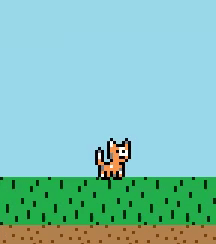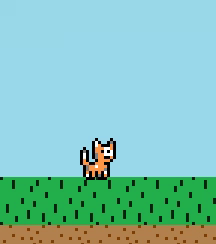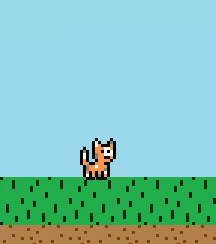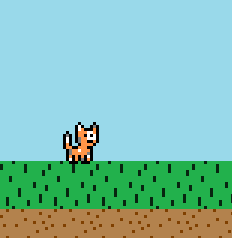Table of contents
Player States
The Player has several different states it can be in based on the value of its playerState instance variable. Each state can lead to another state based on the player’s actions each cycle of the game loop. The states also dictate which animation/frames the player should switch to (e.g. player will switch to the walking animation when in the WALKING state) The PlayerState enum in the Level package define the following states that the player can be in:
- STANDING – player is standing still
- WALKING – player is walking
- JUMPING – player is jumping (or falling)
- CROUCHING – player is crouching
Player Standing State
If the player is on the ground and no keys are pressed, the player will enter its STANDING state, where it does nothing and just waits for another key to be pressed which will activate another state. The playerStanding method contains the simple logic for the STANDING state, which looks like this:
// player STANDING state logic
protected void playerStanding() {
// if walk left or walk right key is pressed, player enters WALKING state
if (Keyboard.isKeyDown(MOVE_LEFT_KEY) || Keyboard.isKeyDown(MOVE_RIGHT_KEY)) {
playerState = PlayerState.WALKING;
}
// if jump key is pressed, player enters JUMPING state
else if (Keyboard.isKeyDown(JUMP_KEY) && !keyLocker.isKeyLocked(JUMP_KEY)) {
keyLocker.lockKey(JUMP_KEY);
playerState = PlayerState.JUMPING;
}
// if crouch key is pressed, player enters CROUCHING state
else if (Keyboard.isKeyDown(CROUCH_KEY)) {
playerState = PlayerState.CROUCHING;
}
}
It really just checks for key presses and if so sets the player to a new state. Not much else to do when you’re standing still.
While standing, the player uses either the STAND_RIGHT or STAND_LEFT animation.
Player Walking State

If the player is on the ground and either the right or left arrow key is pressed, the player will enter its WALKING state, where it will move either to the left or to the right by a set number of pixels. If no keys are pressed while in this state, the player will stop moving and go back into its STANDING state. How fast the player walks is determined by the walkSpeed instance variable. The playerWalking method contains the logic for the WALKING state. The player will change the direction it’s facing based on which arrow key is pressed.
While walking, the player uses either the WALK_RIGHT or WALK_LEFT animation.
Player Jumping State

This state’s logic is a bit more complicated from the others. If the player is on the ground and presses the up arrow key, the player will enter its JUMPING state. The player’s airGroundState will be changed to AIR, and the player will start rising until gravity catches up, at which point the player will fall downwards until it hits the ground again. Upon reaching the ground, the player’s airGroundState will be changed back to GROUND and the player will transition into either a standing or walking state. While in the air in the JUMPING state, the player can move left and right, but will not change the direction it is facing. The player is still considered in JUMPING state while it is falling downwards, and if the player runs off the edge of a cliff and ends up in the air, that is also considered JUMPING state – basically if the player is in the air, it is put in JUMPING state. I probably should have made a separate falling state but…eh it’s not really needed.
The player’s jumping physics are all determined through instance variable values (gravity, jumpHeight, jumpDegrade, terminalVelocityY, and momentumYIncrease) which alter how high the player jumps, how fast the player falls, and what the peak of the jump looks like in terms of motion. Changing these values can drastically change how the player jumps. The Cat player subclass has its values set to that when it jumps, it will rise up quickly to its peak, wait a bit, and then slowly begin to pick up falling speed. Typically in platforming games, the goal is to NOT match real life physics, but instead make physics that are actually fun for the player. A player “in control” of their player character’s jump is essential to making a successful platformer game.
The actual jump algorithm doesn’t do all that much. When up is pressed, the user’s y velocity is decreased (moving upwards) by the value of jumpHeight each frame. Also, jumpHeight is lowered slightly by jumpDegrade each frame, until eventually no more upwards y velocity is applied to the player. When this happens, the user starts to fall as gravity takes over. Each frame, gravity is always added to the player (just like in real life, gravity is always in effect!). Also, each frame the user’s momentum downwards is slightly increased by the value of momentumYIncrease. This gives off the effect that the player is falling faster over time, until its fall speed reaches the value of terminalVelocityY, at which point it can no longer increase in fall speed. Once the player touches the ground, the jump/fall ends.
While rising upwards (jumping), the player uses either the JUMP_RIGHT or JUMP_LEFT animation. While falling downwards, the player uses either the FALL_RIGHT or FALL_LEFT animation.
Player Crouching State

If the player is on the ground and presses the down arrow key, the player will enter its CROUCHING state. Basically, the player goes lower to the ground to shrink its hurtbox, but that’s all it does. Currently, the player cannot walk out of CROUCHING state, but they can jump out of it.
